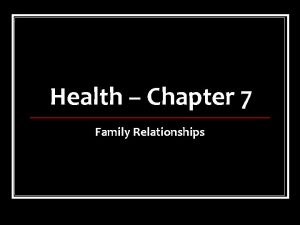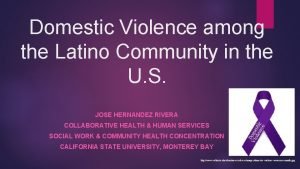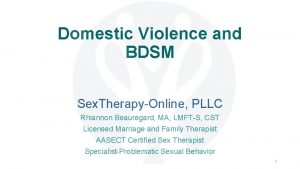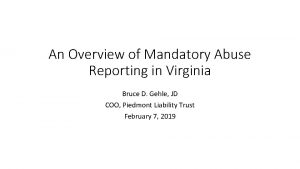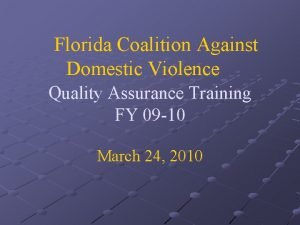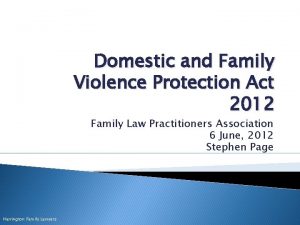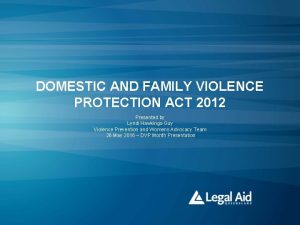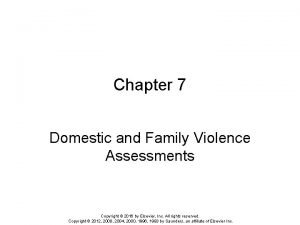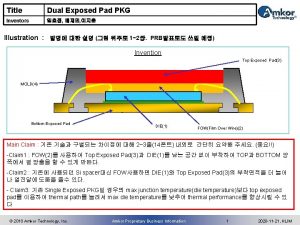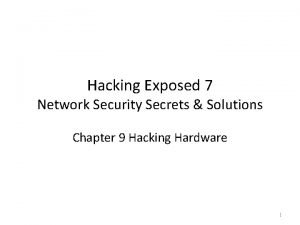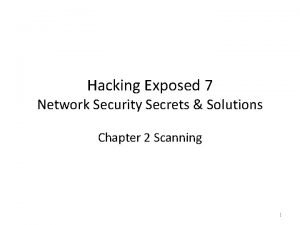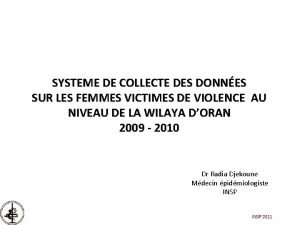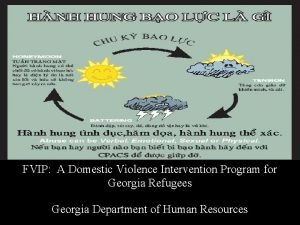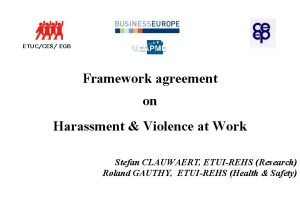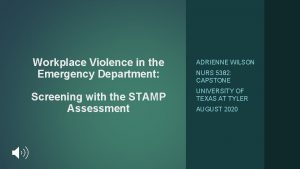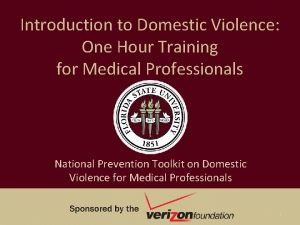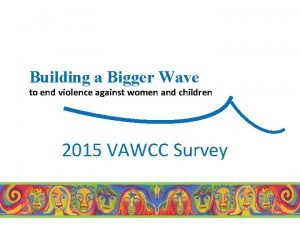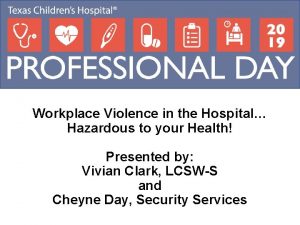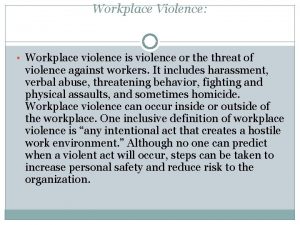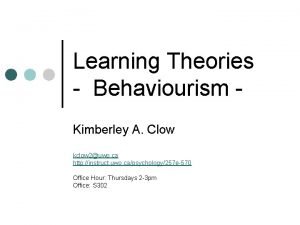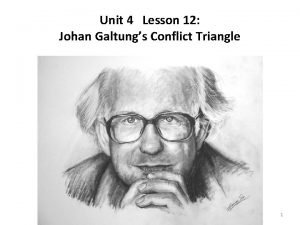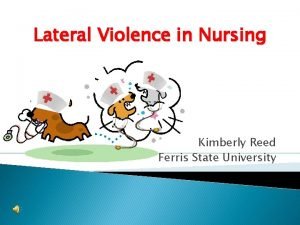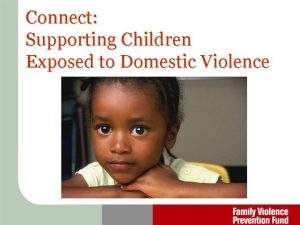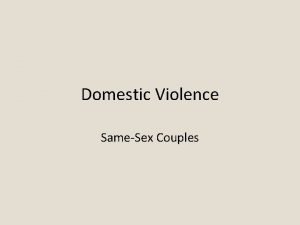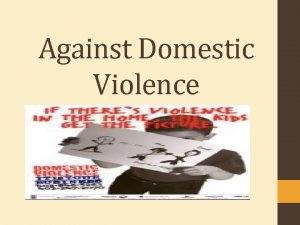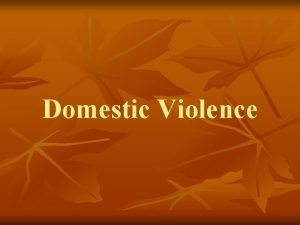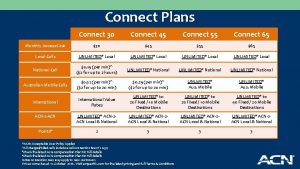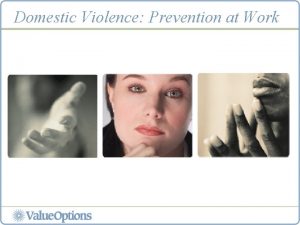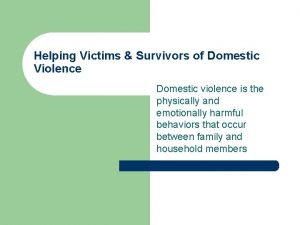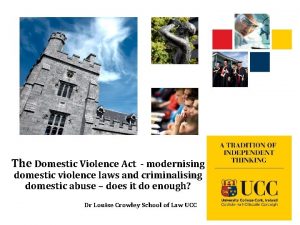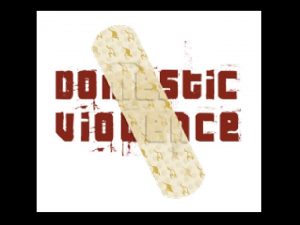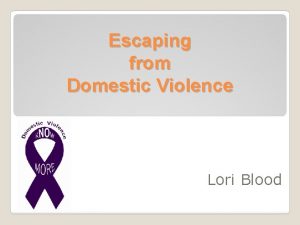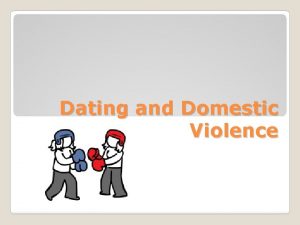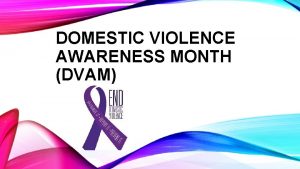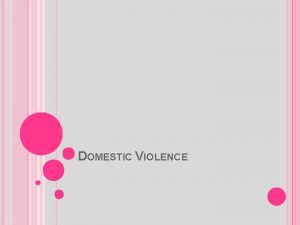Connect Supporting Children Exposed to Domestic Violence Agenda









































- Slides: 41

Connect: Supporting Children Exposed to Domestic Violence

Agenda • Welcome and Introductions • Family Dynamics and Domestic Violence • What Children Experience • Parenting and Supporting Children Affected by DV Slide # 2

Introductions • Tell us your name • And share a nickname you’ve been called (or wouldn’t mind being called!) Slide # 3

Getting Started 1. Read the question on the card and share it with your group 2. Discuss the question 3. Develop a two sentence response in 5 minutes 4. Share your question and response with the large group Slide # 4

What do you think? #1 Why is it important for resource families to know about domestic violence? #2 How would you feel about a child if you learned that s/he lived in a home where domestic violence occurred? Slide # 5

What do you think? #3 How would you feel about a child’s birth parents if you learned that the child came from a home where domestic violence took place? Would you feel differently about the victim parent versus the abusive parent? Slide # 6

What do you think? #4 How might you support children who have experienced domestic violence differently than other children? #5 In what ways are domestic violence and child maltreatment connected? Slide # 7

Family Violence refers to violence between any family members such as: • intimate partner violence (also known as domestic violence) • abuse of a parent by a child • elder abuse • sibling abuse • child maltreatment Slide # 8

Domestic and Dating Violence: Patterns of coercive and controlling behaviors perpetrated by an adult or teen against an intimate partner. Domestic and dating violence are NOT just physical or sexual assault! Slide # 9

A Few Statistics… One in four women report experiencing violence in an intimate relationship at some point in their life (Centers for Disease Control, 2008) 15. 5 million children live in households where domestic violence has occurred within the past year (Mc. Donald et al, 2006) 62% of 11 -14 year olds say they know friends who have been verbally abused by a boyfriend or girlfriend (Liz Claiborne, Inc, 2008) One in five 13 -14 year olds say they know friends and peers who have been struck in anger by a boyfriend or girlfriend (Liz Claiborne, Inc, 2008) Slide # 10

Why do Men use Violence In Intimate Partner Relationships? Some ideas people have: • to establish control • acting out culturally designated roles • mirroring violence in society • because they can get away with it • it is learned behavior Remember: Not every act of violence between two intimate partners is domestic violence. DV is not an isolated incident, but a pattern of coercive and controlling behavior. Slide # 11

Power and Control Wheel What are other examples for each section on the Power and Control Wheel? Slide # 12

Why do Women Stay? ? ? Slide # 13

Why might it be difficult to work with parents who are victims or perpetrators of domestic violence? Slide # 14

Remember: • DV situations can be hard for anyone to manage. • It’s good to seek help and emotional support. Where can you find help in your community? Slide # 15

Exposure to Domestic Violence: Not all children are affected by domestic violence in the same way. Slide # 16

Examples of How Children are Exposed • hearing threats of physical harm • feeling tension building in home prior to assault • being hit/threatened while in mother’s arms • hearing/seeing assault on their mother • being denied care because mother is injured or depressed • being forced to watch or participate in violence against their mother • seeing aftermath of violent incident • having their relationship with their non-violent parent undermined • being taken hostage to force mother to return home • being enlisted by violent parent to align against mother • experiencing the loss of a parent due to murder/suicide Slide # 17

Factor: The Child’s Age The younger the child, the more harmful the impact may be. Slide # 18

Factor: The Child’s Developmental Stage Exposure to domestic violence can affect the tasks or milestones of the particular child’s stage of development. Slide # 19

Factor: Severity, Proximity, Duration and Frequency of Exposure A child directly exposed to extreme, ongoing and/or frequent violence is more likely to be seriously emotionally harmed. Slide # 20

Factor: The Child’s Gender Boys and girls may be affected differently Slide # 21

Factor: The Child’s Role in the Family Children exposed to domestic violence take on different roles in families that may change over time. • Caretaker • Confidant • Assistant • Overachiever/ “perfect” • Referee • Scapegoat Slide # 22

Factor: Personal Characteristics of the Child Some children have a strong sense of self and are able to weather their exposure to violence by drawing on internal strength. Slide # 23

Factor: Presence or absence of loving, supportive adults The single most critical factor in how children weather exposure to domestic violence is the presence of at least ONE loving and supportive adult in their life. That ONE adult may be YOU!! Slide # 24

Factor: Responsiveness of systems Knowledgeable and skilled professionals who understand respond effectively to families can play a significant role in how children are impacted. Slide # 25

What are some of the FEELINGS and BEHAVIORS that children in your care have displayed? Slide # 26

The impact of exposure to domestic violence on infants and young children may show up as… • low birth weight • exaggerated startle response • somatic complaints • regression in toileting or language • sleep disturbances • difficulty attaching to caregiver • hyper-vigilance • separation anxiety • eating disorders Slide # 27

In school-aged children: Some kids “over-control” their emotions or behaviors (these are internalized effects of exposure to DV). These children “hold things in”. Some kids “under-control” their emotions or behaviors (these are externalized effects of exposure to DV). These kids are more likely to explode, act up or act out. They cannot manage their impulses. Slide # 28

A good way to understand the effects of DV on children is to look at their drawings. An eight-year-old was asked to draw a picture of his father. He wrote in Spanish: “This is how I see my father because he often gets angry and drunk and his eyes turn red. ” Slide # 29

For adolescents, exposure to DV can result in kids being more likely to. . . • Use drugs or alcohol • Be harmed when they intervene in an assault • Display attitudes supporting the use of violence • Use violence in their own intimate relationships Slide # 30

Another example of a drawing in response to the Question “How do you see your father? ” In this case, the artist is a 13 -year-old boy. Slide # 31

What Does Trauma Look Like? Children who may need professional help: • Cry easily or constantly • Appear emotionless or extremely withdrawn • Have repeated or intrusive thoughts about the event • Have trouble sleeping and/or nightmares • Be “triggered” by a sound, smell, or other reminder of the experience • Have difficulty concentrating • Worry excessively leading to physical complaints (i. e. stomachaches) Slide # 32

Questions: 1. Which of these effects in children are easier for you to handle as a parent? Why? 2. Which of these effects “drive you crazy” or makes it hard for you to parent? Why? Slide # 33

Supporting Children Affected by Domestic Violence Slide # 34

Resource Parents Need to Know • Many children will worry about their mothers safety and will miss their family • Tender loving care (TLC) is important but may not always be enough • Children need to move from unpredictable danger to reliable safety • Relationships may be too close for comfort • There is no quick, easy fix Slide # 35

Resource Parents can Support Children and Promote Healing • Create a predictable world • Add structure and clear expectations • Pay close attention to non-verbal cues • Avoid struggles for power and control • Model healthy and respectful relationships Slide # 36

Resource Parents can Support Children and Promote Healing • Give children choices whenever possible • Help children learn not only what not to do, but what to do instead • Teach children to put feelings into words • Validate children’s feelings about their parents • Create opportunities for children to be successful (i. e. sports, music, art, academics, peer relationships) • Send the right messages Slide # 37

Resource Parents can Support Children and Promote Healing • Prepare children for visits • Advocate for children when they need help in other settings • Be respectful of the children’s parents • Have fun together! • Get support for yourself! Slide # 38

Group Activity 1. Read the case study 2. Discuss the questions at the end of the case study as a group 3. Pick a spokesperson to share with the large group Slide # 39

You have the power to help children heal Final Questions? Slide # 40

Thank you for your participation today! Please visit the Family Violence Prevention Fund at www. endabuse. org Slide # 41
 The three r's for stopping domestic violence
The three r's for stopping domestic violence Domestic violence in the hispanic community
Domestic violence in the hispanic community Domestic violence kink
Domestic violence kink Virginia mandatory reporting law domestic violence
Virginia mandatory reporting law domestic violence Florida coalition against domestic violence
Florida coalition against domestic violence Domestic and family violence protection act 2012
Domestic and family violence protection act 2012 Domestic and family violence protection act 2012
Domestic and family violence protection act 2012 Chapter 7 domestic and family violence assessment
Chapter 7 domestic and family violence assessment Agenda sistemica y agenda institucional
Agenda sistemica y agenda institucional The house of yahweh exposed
The house of yahweh exposed Where are the andes located
Where are the andes located Exposed pad
Exposed pad Exposed station problem
Exposed station problem Hacking exposed 9
Hacking exposed 9 Exposed
Exposed Node 802
Node 802 Bart believes that mice exposed to microwaves
Bart believes that mice exposed to microwaves Which rock weathers most rapidly when exposed to acid rain
Which rock weathers most rapidly when exposed to acid rain Exposed electrical parts
Exposed electrical parts Hacking exposed 9
Hacking exposed 9 Chafing block firefighter
Chafing block firefighter Exposed naked
Exposed naked People media example
People media example Types de la violence
Types de la violence Family violence intervention program georgia
Family violence intervention program georgia Violence at work
Violence at work Framework agreement on harassment and violence at work
Framework agreement on harassment and violence at work Stamp workplace violence
Stamp workplace violence Borderline violence conjugale
Borderline violence conjugale Do violent games cause violence
Do violent games cause violence Conclusion of violence
Conclusion of violence Multicolor wave
Multicolor wave Workplace violence
Workplace violence Chapter 9 resolving conflicts and preventing violence
Chapter 9 resolving conflicts and preventing violence Gandhi king and mandela what made non-violence work dbq
Gandhi king and mandela what made non-violence work dbq Expressive crime
Expressive crime Type 3 workplace violence
Type 3 workplace violence Tv violence
Tv violence Physical violence against women
Physical violence against women Workplace violence continuum
Workplace violence continuum Conflict triangle theory
Conflict triangle theory Define lateral violence in nursing
Define lateral violence in nursing
